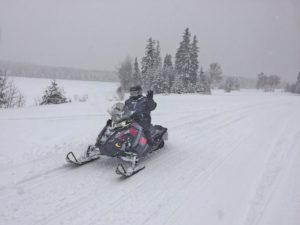I know some of you are not going to approve of what I do for my winter vacation. But if I didn’t love driving and engines, would I really be the guy you want to take your car to for repair?
So, you might as well know it. Every year in late winter I head to Pittsburg, N.H. or Rangeley, Maine, towing a trailer with my snowmobile behind my truck full of Gore-Tex.
This hobby is one that requires a helmet and lots of other gear that costs too much but keeps your hands and face from freezing when you’re cruising into the winter wind at 45 miles per hour all day. That was about my top speed this year, anyway, because I went with my dad. For a guy with his experience in life — he’s 70 — he sure finds himself taking some wrong turns on the trails.

There are people who go faster than we do. But I don’t think snowmobiling is really about speed. It’s a ride along groomed trails through the snowy woods. There are times you pass other drivers, there are even crowds at certain spots, and a kind of camaraderie when people stop to help someone who’s landed in a ditch. Mostly, though, you get a feeling of being far away. It’s liberating. On this network of trails, you can sled all the way to Canada.
Snowmobiling is also about responsiveness. Driving something with a snappy engine is fun for those of us who lumber around in trucks or SUVs most of the time.
My snowmobile has a two-cycle engine, and although there are more and more four-cycle versions of these machines out there, there’s a reason I like mine. Its engine might not be as reliable or long-lasting as a four-cycle model, but it reminds me of the go-karts and dirt bikes I drove when I was a kid.
Even the two-cycle engines are fairly complex nowadays, because manufacturers are trying to get the horsepower out of them and at the same time get them to burn less fuel and put out fewer emissions. Still, there’s a simplicity to the way this engine works. There’s no lubrication system, for example — you have to use a mix of gas and oil.
What’s really different about my snowmobile’s engine and a four-cycle one is the compression ratio. A two-cycle engine’s is higher, which means it extracts more mechanical energy from the air-fuel mix it takes in. You have to think of internal combustion engines as essentially heat machines, where higher compression ratios permit the same combustion temperature to be reached with less fuel, while giving a longer expansion cycle, creating more mechanical power and lowering the exhaust temperature.
What this means is, even if my speeds aren’t high — because that’s not exactly what I’m after when I’m sledding — my snowmobile is snappy in a way no car is.
I suppose technically that’s not true. There are some supercharged cars out there, even non-NASCAR racing machines that have high performance engines. Lexus, BMW, and Audi are some I see in my shop. But those are getting their higher compression through turbochargers or nitrous oxide. Whereas my snowmobile is getting it the old-fashioned way, with a smaller compression chamber.
The way I see it, my snowmobile gives me a way to drive a high-performance vehicle of my very own.
